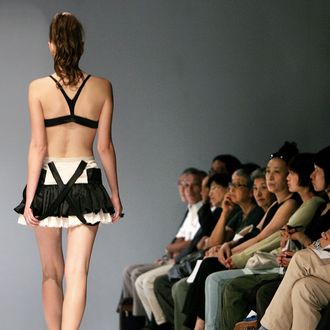
Just about everyone has gotten into an embarrassing-in-retrospect debate with friends over who is and isn’t hot. Gauging other people’s attractiveness is, for better or worse, a pretty inevitable part of life. But to what extent are our views of people’s attractiveness independent, and to what extent are they influenced by other people’s opinions? A new study by Haiyang Yang of Johns Hopkins University and Leonard Less of the National University of Singapore sought to find out.
The study, published in Advances in Consumer Research with the memorable title “Instantaneously Hotter: the Dynamic Revision of Beauty Assessment Standards,” used photos from the site hotornot.com, attractiveness ratings from the site, as well as new ratings of HOTorNOT photos generated by a lab experiment (citing another study, the authors claim hotornot.com has been shown to actually be a pretty accurate predictor of how attractive people are seen to be by others).
There were various experimental setups, but the key part was this: Sometimes, after rating a photo, participants saw how other people had rated that photo, and sometimes they didn’t. The researchers found that when people saw ratings after making their own judgement, in subsequent judgments they got closer and closer to other people’s overall average rating of that photo. In other words — and I’m making up the specific numbers — if on the first photo they ranked they were off by 2 points on a 10-point scale as compared to the average, by the 20th photo they were off by, on average, 1.25 points.
The researchers interpret this as meaning that as people rated photos, they were influenced by other people’s standards of beauty and internalized these standards without even knowing it. And this certainly fits with certain other things we know about how these standards are transmitted throughout a culture — it’s pretty clear that no man or woman is an island when it comes to figuring out what he or she finds attractive.
Still, the fact that the “influence” in this study is so vague and anonymous gives me pause. What if you ran a similar experiment where people judged how reliable a toaster seemed based on a photo and description of it? Or a car? We know that people are influenced by weird stuff when they’re asked to make numerical guesses and have access to other numerical information to help guide those guesses. For instance, there’s the so-called anchoring effect: If you say to one group of people “There are more than 200 million people in the U.S. How many do you think there are?” and to another “There are more than 300 million people in the U.S. How many do you think there are?” the latter group will probably generate higher estimates.
I’m not saying it’s the anchoring effect specifically that’s at work here — just that there could be explanations for why people’s attractiveness ratings converge on others’ attractiveness ratings that have more to do with quirks about the psychology of numbers than with actual standards of beauty. This wouldn’t be a hard thing to test for: all you’d need is to conduct some aforementioned arbitrary toaster- (or whatever-) rating. If people’s ratings of toasters converge in the same way their ratings of humans converge, then there could be limits to what these sorts of online experiments can tell us about how human attractiveness works in the real world.
So this is definitely an interesting finding, but it should probably be taken with a grain of salt until researchers can trot out some more photos of hot people … and, hopefully, toasters.




